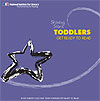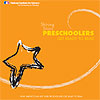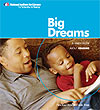Early Childhood Resources
PresentationsEarly Reading First presentation from the Secretary's Reading Academies, Washington, D.C. (December 2001).Reports The National Reading Panel (NRP) reviewed more than 100,000 studies on reading and identified five components essential to a child's ability to learn to read: phonics, phonemic awareness, fluency, vocabulary, and comprehension. NRP's findings and their analysis and discussion of these five areas of reading instruction are published in Reading First: The Research Building Blocks for Teaching Children to Read. Additional information is available on the NRP's publications page.
Related Associations and Organizations An Early Reading First Resource Sampler The following bibliography represents a small sample of the scientifically based research and resources available that support the Early Reading First goals. The list is not exhaustive, and the Department will add other relevant research and resources in the future. Adams, M.J., Foorman, B.R., Lundberg, I., & Beeler, T. (1998). Phonemic Awareness in Young Children. Baltimore: Paul H. Brookes Publishing. This book addresses the "research to practice" issue in phonemic awareness and includes activities that stimulate the development of "phonemic awareness" in early education programs. While MOST teachers are familiar with the term "phonemic awareness" and its importance in the process of acquiring literacy, but knowing how to teach and support "phonemic awareness" learning has been a challenge for many. The authors intend to close the gap between the research findings and classroom instruction by providing a developmental curriculum in "phonemic awareness" based upon validated classroom research that originated in Sweden and Denmark, and was then adapted and researched in classrooms in the United States. Apel, K., & Masterson, J. (2001). Beyond Baby Talk: From Sounds to Sentences - A Parent's Guide to Language Development. California: Prima Publishing. Sponsored by the American Speech-Language-Hearing Association, this book describes how children develop language from their earliest words to sentences. With the understanding that parents are the primary language role models for their children, the authors provide parents with a guide to understanding language development as well as ways in which they can interact with their children to promote language development. Burns, M.S., Griffin, P., & Snow, C.E. (Eds.). (1999). Starting Out Right: A Guide to Promoting Children's Reading Success. Washington, D.C.: National Academy Press. This book is edited by members of the Committee on the Prevention of Reading Difficulties in Young Children. It is intended for parents, teachers, policymakers, and community members. The book addresses the following central questions:
The goal of the book is to share a wealth of knowledge based upon extensive guidelines, program descriptions, advice on resources, and strategies that can be used in everyday life. Gopnik, A., Meltzoff, A.N., & Kuhl, P.K. (1999). The Scientist in the Crib. New York: Morrow. This book looks with great detail into the relationship between science and young children's development. There have been many rigorous scientific studies conducted that have helped us better understand how babies think and learn. The latest research on early childhood development tells us that babies and young children know and learn much more about the world around them than we ever have imagined. This book is not the typical parenting advice or "how to" book. Rather, it strives to take a different road and look at the science of babies' minds. Hart, B., & Risley, T.R. (1999). The Social World of Children: Learning to Talk. Baltimore: Paul H. Brookes Publishing. This book follows the groundbreaking study reported by Hart and Risley in their earlier book, Meaningful Differences in the Everyday Experiences of Young American Children. It goes beyond the discussion in the earlier book on the role of language experience in the intergenerational transmission of language competence and examines the patterns in that transmission. The authors provide tables and figures with their data and thoroughly discuss their findings. Hart and Risley state that they have a simple message for parents: their conversation matters when their children are young. Talking with children provides them with experiences that are important to both their cognitive and their social/emotional learning. The authors provide evidence that the language tools provided to children through conversation can contribute at least as much to a child's future success as their heredity and their choice of friends . Neuman, S., & Copple, C., Bredekamp, S. (2000). Learning to Read and Write: Developmentally Appropriate Practices for Young Children. Washington D.C.: National Association for the Education of Young Children. This book is the product of a professional collaboration between early childhood educators and reading specialists. It explains the position statement of the International Reading Association and the National Association for the Education of Young Children on the all important and controversial topic of when and how to teach young children to read and write. Also included is a summary of effective teaching practices for preschool teachers, a section on frequently asked questions, and a glossary of terms in early literacy. Finally, to help teachers consider the value of what they are doing across the dimensions of literacy, there is a brief self-inventory (Taking Stock of What You Do to Promote Children's Literacy). Neuman, S.B., & Dickinson, D.K. (Eds.). (2001). Handbook of Early Literacy Research. New York: Guilford Press. This volume examines current research on early literacy and intervention. The Handbook begins by addressing broad questions about the nature of early literacy, and then continues by summarizing current knowledge on cognitive development, and emphasizing the importance of cultural contexts in the acquisition of literacy. Subsequent chapters focus on various skills and knowledge that emerge as children become literate as well as the roles of peers and families in this process. The book devotes attention to the importance of meeting the literacy needs of all children and emphasizes the importance of coordinated school, family, and social services to provide the necessary support for those children who struggle most in school. Various approaches to instruction, assessment, and early intervention and research on the efficacy of these approaches are described. Snow, C.E., Burns, S., & Griffin, P. (Eds.). (1998). Preventing Reading Difficulties in Young Children. Washington, D.C.: National Academy Press. This book is a summary report developed from the findings of the Committee on the Prevention of Reading Difficulties in Young Children. It examines research findings to provide an "integrated picture of how reading develops and how reading instruction should proceed (p. vi)." The core message of the book with regard to reading instruction is: "that reading instruction should integrate attention to the alphabetic principle with attention to the construction of meaning and opportunities to develop fluency (p. vii)." The research reviewed in this book includes studies on normal reading development and instruction; on risk factors that can be useful in identifying children at risk for reading failure; and on prevention, intervention, and instructional approaches to ensuring the most optimal reading outcomes. The committee emphasizes the importance of high-quality preschool and kindergarten environments and their contribution to providing a critical foundation to facilitate children's acquisition of essential reading skills. |



